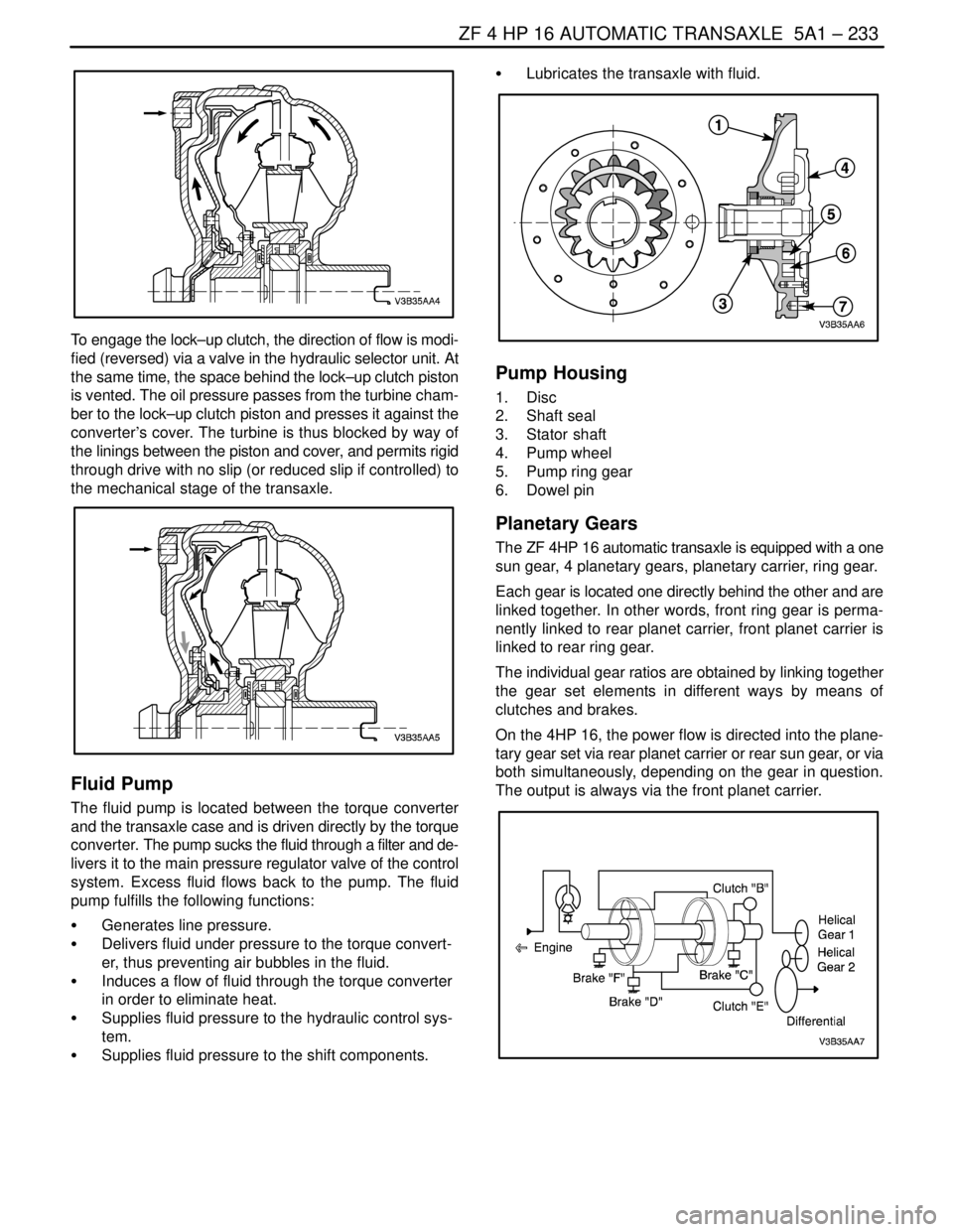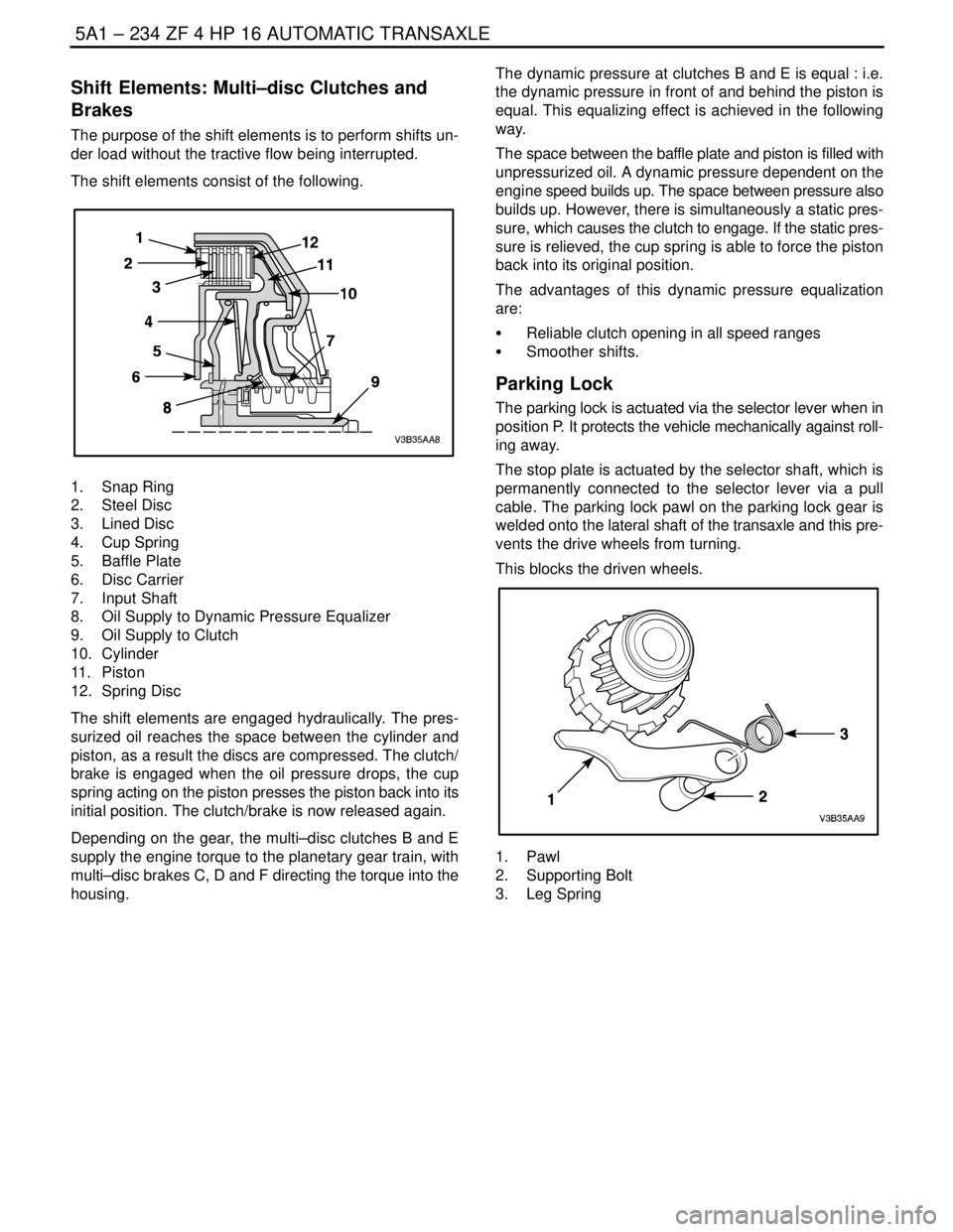2004 DAEWOO NUBIRA gear selector
[x] Cancel search: gear selectorPage 1533 of 2643

5A1 – 184IZF 4 HP 16 AUTOMATIC TRANSAXLE
DAEWOO V–121 BL4
RangePark/
Neutr
alRever
seD321
GearNR1st2nd3rd4th1st2nd3rd1st2nd1st
Solenoid Valve
1ONON/
OFFON/
OFFON/
OFFON/
OFFON/
OFFON/
OFFON/
OFFON/
OFFON/
OFFON/
OFFON/
OFF
Solenoid Valve
2ONONONOFFOFFOFFONOFFOFFONOFFON
Line Pressure
Control Sole-
noid Valve 3
(EDS 3)OFFOFFOFFONON/
OFFON/
OFFOFFONON/
OFFOFFONOFF
Line Pressure
Control Sole-
noid Valve 4
(EDS 4)ONOFFONONONOFFONONONONONON
Line Pressure
Control Sole-
noid Valve 5
(EDS 5)OFFOFFONONOFFOFFONONOFFONONON
Line Pressure
Control Sole-
noid Valve 6
(EDS 6)ONOFFONONONOFFONONONONONON
Brake BAAAAAAAA
Brake CH
Brake DH
Clutch EAAAAAA
Brake FHHHHHHH
Lock–up
ClutchA
A = Applied
H = Holding
ON = The solenoid is energized.
OFF = The solenoid is de–energized.
** = Manual Second–Third gear is only available above approximately 100 km/h (62 mph).
*** = Manual First–Second gear is only available above approximately 60 km/h (37 mph).
Note : Manual First–Third gear is also possible at high vehicle speed as a safety feature.
DIAGNOSTIC TROUBLE CODE(DTC) P1884
4–3 SHIFT MALFUNCTION
Circuit Description
The special feature of 4HP 16 Auto Transaxle is that it op-
erates without freewheels. Shifting between individual
gears takes place by means of overlapping clutch engage-
ment and release.
The advantage of overlap shifting are as follows:
– The transaxle can be of more compact design
and is lighter on account of the absence of free-
wheels and the lower number of shift elements.– Lower drag losses, i.e. higher efficiency.
– Lower peak torque acting on the components and
driveline.
However, overlap shifting necessitates high–performance
hardware and software, and precision engine signals.
Conditions for Setting the DTC
S Transmission oil temperature is greater than –10°C
(14°F).
S Selector lever is not in N(Neutral), P(Park) position.
S System voltage is greater than 9 volts.
Page 1535 of 2643

5A1 – 186IZF 4 HP 16 AUTOMATIC TRANSAXLE
DAEWOO V–121 BL4
RangePark/
Neutr
alRever
seD321
GearNR1st2nd3rd4th1st2nd3rd1st2nd1st
Solenoid Valve
1ONON/
OFFON/
OFFON/
OFFON/
OFFON/
OFFON/
OFFON/
OFFON/
OFFON/
OFFON/
OFFON/
OFF
Solenoid Valve
2ONONONOFFOFFOFFONOFFOFFONOFFON
Line Pressure
Control Sole-
noid Valve 3
(EDS 3)OFFOFFOFFONON/
OFFON/
OFFOFFONON/
OFFOFFONOFF
Line Pressure
Control Sole-
noid Valve 4
(EDS 4)ONOFFONONONOFFONONONONONON
Line Pressure
Control Sole-
noid Valve 5
(EDS 5)OFFOFFONONOFFOFFONONOFFONONON
Line Pressure
Control Sole-
noid Valve 6
(EDS 6)ONOFFONONONOFFONONONONONON
Brake BAAAAAAAA
Brake CH
Brake DH
Clutch EAAAAAA
Brake FHHHHHHH
Lock–up
ClutchA
A = Applied
H = Holding
ON = The solenoid is energized.
OFF = The solenoid is de–energized.
** = Manual Second–Third gear is only available above approximately 100 km/h (62 mph).
*** = Manual First–Second gear is only available above approximately 60 km/h (37 mph).
Note : Manual First–Third gear is also possible at high vehicle speed as a safety feature.
DIAGNOSTIC TROUBLE CODE(DTC) P1885
3–1 SHIFT MALFUNCTION
Circuit Description
The special feature of 4HP 16 Auto Transaxle is that it op-
erates without freewheels. Shifting between individual
gears takes place by means of overlapping clutch engage-
ment and release.
The advantage of overlap shifting are as follows:
– The transaxle can be of more compact design
and is lighter on account of the absence of free-
wheels and the lower number of shift elements.– Lower drag losses, i.e. higher efficiency.
– Lower peak torque acting on the components and
driveline.
However, overlap shifting necessitates high–performance
hardware and software, and precision engine signals.
Conditions for Setting the DTC
S Transmission oil temperature is greater than –10°C
(14°F).
S Selector lever is not in N(Neutral), P(Park) position.
S System voltage is greater than 9 volts.
Page 1537 of 2643

5A1 – 188IZF 4 HP 16 AUTOMATIC TRANSAXLE
DAEWOO V–121 BL4
RangePark/
Neutr
alRever
seD321
GearNR1st2nd3rd4th1st2nd3rd1st2nd1st
Solenoid Valve
1ONON/
OFFON/
OFFON/
OFFON/
OFFON/
OFFON/
OFFON/
OFFON/
OFFON/
OFFON/
OFFON/
OFF
Solenoid Valve
2ONONONOFFOFFOFFONOFFOFFONOFFON
Line Pressure
Control Sole-
noid Valve 3
(EDS 3)OFFOFFOFFONON/
OFFON/
OFFOFFONON/
OFFOFFONOFF
Line Pressure
Control Sole-
noid Valve 4
(EDS 4)ONOFFONONONOFFONONONONONON
Line Pressure
Control Sole-
noid Valve 5
(EDS 5)OFFOFFONONOFFOFFONONOFFONONON
Line Pressure
Control Sole-
noid Valve 6
(EDS 6)ONOFFONONONOFFONONONONONON
Brake BAAAAAAAA
Brake CH
Brake DH
Clutch EAAAAAA
Brake FHHHHHHH
Lock–up
ClutchA
A = Applied
H = Holding
ON = The solenoid is energized.
OFF = The solenoid is de–energized.
** = Manual Second–Third gear is only available above approximately 100 km/h (62 mph).
*** = Manual First–Second gear is only available above approximately 60 km/h (37 mph).
Note : Manual First–Third gear is also possible at high vehicle speed as a safety feature.
DIAGNOSTIC TROUBLE CODE(DTC) P1886
4–2 SHIFT MALFUNCTION
Circuit Description
The special feature of 4HP 16 Auto Transaxle is that it op-
erates without freewheels. Shifting between individual
gears takes place by means of overlapping clutch engage-
ment and release.
The advantage of overlap shifting are as follows:
– The transaxle can be of more compact design
and is lighter on account of the absence of free-
wheels and the lower number of shift elements.– Lower drag losses, i.e. higher efficiency.
– Lower peak torque acting on the components and
driveline.
However, overlap shifting necessitates high–performance
hardware and software, and precision engine signals.
Conditions for Setting the DTC
S Transmission oil temperature is greater than –10°C
(14°F).
S Selector lever is not in N(Neutral), P(Park) position.
S System voltage is greater than 9 volts.
Page 1582 of 2643

ZF 4 HP 16 AUTOMATIC TRANSAXLE 5A1 – 233
DAEWOO V–121 BL4
To engage the lock–up clutch, the direction of flow is modi-
fied (reversed) via a valve in the hydraulic selector unit. At
the same time, the space behind the lock–up clutch piston
is vented. The oil pressure passes from the turbine cham-
ber to the lock–up clutch piston and presses it against the
converter’s cover. The turbine is thus blocked by way of
the linings between the piston and cover, and permits rigid
through drive with no slip (or reduced slip if controlled) to
the mechanical stage of the transaxle.
Fluid Pump
The fluid pump is located between the torque converter
and the transaxle case and is driven directly by the torque
converter. The pump sucks the fluid through a filter and de-
livers it to the main pressure regulator valve of the control
system. Excess fluid flows back to the pump. The fluid
pump fulfills the following functions:
S Generates line pressure.
S Delivers fluid under pressure to the torque convert-
er, thus preventing air bubbles in the fluid.
S Induces a flow of fluid through the torque converter
in order to eliminate heat.
S Supplies fluid pressure to the hydraulic control sys-
tem.
S Supplies fluid pressure to the shift components.S Lubricates the transaxle with fluid.
Pump Housing
1. Disc
2. Shaft seal
3. Stator shaft
4. Pump wheel
5. Pump ring gear
6. Dowel pin
Planetary Gears
The ZF 4HP 16 automatic transaxle is equipped with a one
sun gear, 4 planetary gears, planetary carrier, ring gear.
Each gear is located one directly behind the other and are
linked together. In other words, front ring gear is perma-
nently linked to rear planet carrier, front planet carrier is
linked to rear ring gear.
The individual gear ratios are obtained by linking together
the gear set elements in different ways by means of
clutches and brakes.
On the 4HP 16, the power flow is directed into the plane-
tary gear set via rear planet carrier or rear sun gear, or via
both simultaneously, depending on the gear in question.
The output is always via the front planet carrier.
Page 1583 of 2643

5A1 – 234IZF 4 HP 16 AUTOMATIC TRANSAXLE
DAEWOO V–121 BL4
Shift Elements: Multi–disc Clutches and
Brakes
The purpose of the shift elements is to perform shifts un-
der load without the tractive flow being interrupted.
The shift elements consist of the following.
1. Snap Ring
2. Steel Disc
3. Lined Disc
4. Cup Spring
5. Baffle Plate
6. Disc Carrier
7. Input Shaft
8. Oil Supply to Dynamic Pressure Equalizer
9. Oil Supply to Clutch
10. Cylinder
11. Piston
12. Spring Disc
The shift elements are engaged hydraulically. The pres-
surized oil reaches the space between the cylinder and
piston, as a result the discs are compressed. The clutch/
brake is engaged when the oil pressure drops, the cup
spring acting on the piston presses the piston back into its
initial position. The clutch/brake is now released again.
Depending on the gear, the multi–disc clutches B and E
supply the engine torque to the planetary gear train, with
multi–disc brakes C, D and F directing the torque into the
housing.The dynamic pressure at clutches B and E is equal : i.e.
the dynamic pressure in front of and behind the piston is
equal. This equalizing effect is achieved in the following
way.
The space between the baffle plate and piston is filled with
unpressurized oil. A dynamic pressure dependent on the
engine speed builds up. The space between pressure also
builds up. However, there is simultaneously a static pres-
sure, which causes the clutch to engage. If the static pres-
sure is relieved, the cup spring is able to force the piston
back into its original position.
The advantages of this dynamic pressure equalization
are:
S Reliable clutch opening in all speed ranges
S Smoother shifts.
Parking Lock
The parking lock is actuated via the selector lever when in
position P. It protects the vehicle mechanically against roll-
ing away.
The stop plate is actuated by the selector shaft, which is
permanently connected to the selector lever via a pull
cable. The parking lock pawl on the parking lock gear is
welded onto the lateral shaft of the transaxle and this pre-
vents the drive wheels from turning.
This blocks the driven wheels.
1. Pawl
2. Supporting Bolt
3. Leg Spring
Page 1585 of 2643

5A1 – 236IZF 4 HP 16 AUTOMATIC TRANSAXLE
DAEWOO V–121 BL4
ELECTRONICAL COMPONENTS
Selector Lever/Program Switch
The driver engages the travel position via the selector le-
ver:
P : Park Position
R : Reverse
N : Neutral
D : Forward Speeds
Park/Neutral Position Switch
The Park/Neutral Position Switch is located on the selec-
tor shaft and informs the TCM of the current selector lever
position P–R–N–D–3–2–1.
The selector lever position is transmitted to the TCM in en-
coded form along 4 lines. The encoding is such that mal-
functions in the connecting lead are identified.
The Park/Neutral Position Switch is located on the selec-
tor shaft, which is connected to the selector lever via a pull
cable. In addition, the Park/Neutral Position Switch con-
trols the starter interlock, the reversing light and the selec-
tor lever position indicator on the instrument panel.
Signal Combination
L1L2L3L4
P00120
R00012
N01200
D1212120
31212012
21201212
10121212
Automatic Transaxle Output Speed Sensor
(A/T OSS)
The vehicle A/T OSS is a magnetic inductive pickup that
relays information relative to vehicle speed to the TCM.
Vehicle speed information is used by the TCM to control
shift timing, line pressure, and TCC (lock–up clutch) apply
and release.
The output speed sensor mounts in the case at the speed
sensor rotor, which is pressed onto the spur gear. An air
gap of 0.1mm~1.3mm(0.004~0.05in) is maintained be-
tween the sensor and the teeth on the spur gear teeth. The
sensor consists of a permanent magnet surrounded by a
coil of wire.
As the differential rotates, an AC signal is generated by the
output speed sensor (OSS).
Automatic Transaxle Input Speed Sensor
(A/T ISS)
The A/T ISS is a magnetic inductive pickup that relays in-
formation relative to transaxle input speed to the TCM.
The TCM uses transaxle input speed information to con-
trol line pressure, TCC apply and release and transaxle
shift patterns. This information is also uses to calculate the
appropriate operating gear ratios and TCC slippage.
The input speed sensor mounts onto piston B that is inside
of valve body.
An air gap of 1.8~2.2mm(0.07~0.086inch) is maintained
between the sensor and the piston B.
The sensor consists of a permanent magnet surrounded
by a coil of wire. As the piston B is driven by the turbine
shaft, an AC signal induced in the input speed sensor.
Higher vehicle speeds induce a higher frequency and volt-
age measurement at the sensor.
Sensor resistance should measure between 825~835
ohms at 20°C (68°F). Sensor can measure from
1,000~8,000HZ.
Page 1643 of 2643

AISIN AUTOMATIC TRANSAXLE 5A2 – 53
DAEWOO V–121 BL4
DIAGNOSTIC TROUBLE CODE (DTC) P0713
TRANSMISSION FLUID TEMPERATURE (TFT) SENSOR
CIRCUIT HIGH INPUT
Conditions for Setting the DTC
S TCM detects that A/D value of Transmission Fluid
Temperature sensor (TFT) signal is less than 15
and the minimum A/D value is more than 943,
when it is past 15 minutes after ignition ON.(A/D
value 943 : 4.7 v)
S After 1 time of above detection.
S Gear selector position is except P and N.
S Engine revolution is 400 rpm or greater.
Action Taken When the DTC Sets
S TCM will request the illumination of MIL and store
DTC when TCM detects a failure on the first ignition
cycle.
S TCM judges the temperature of the transmission
fluid is 200°C (392°F).
S No lockup control
S No 4th gear
S No self–learning controlS No timing solenoid control N–D
Conditions for Clearing the DTC
S The TCM turns off the MIL when no further failures
detected for three consecutive ignition cycles.
S The scan tool can clear the DTC from the TCM his-
tory.
S The TCM clears the DTC from the TCM history
memory after forty consecutive warm up cycles
without fault.
S TCM detects the temperature of the transmission
fluid is between 0°C (32°F) and 150°C (302°F) for
10 seconds continuously.
Cause of Failure
S Wiring harness or connector between Transmission
Fluid Temperature (TFT) sensor and TCM
S TFT sensor
S TCM
Page 1688 of 2643

5A2 – 98IAISIN AUTOMATIC TRANSAXLE
DAEWOO V–121 BL4
Filling Procedure
1. Remove the drainage container and lower the ve-
hicle.
2. Add three–fourths of the recommended amount of
ISU DEXRON III.
3. Start the engine and allow it to reach normal oper-
ating temperature.
4. Shift the gear selector through all positions.
5. Check the fluid level and add fluid until the dipstick
indicates a safe level.
LOCATING FLUID LEAKS
General Method
1. Verify that the material leaking is transaxle fluid.
2. Thoroughly clean the suspected leak area.
3. Allow the transaxle to reach the normal operating
temperature of 176–194°F (80–90°C).
4. Park the vehicle over a clean paper or a clean card-
board.
5. Turn the engine OFF and look for fluid spots on the
paper.
6. Make the necessary repairs to correct that leak.
Powder Method
1. Thoroughly clean the suspected leak area.
2. Apply an aerosol type powder, such as foot powder,
to the suspected leak area.
3. Allow the transaxle to reach the normal operating
temperature of 176–194°F (80–90°C).
4. Turn the engine OFF.
5. Inspect the suspected leak area and trace the leak
path through the powder to find the source of the
leak.
6. Make the necessary repairs to correct the leak.
Once the leak point is found, the source of the leak must
be determined and repaired.
CASE PORSITY REPAIR
1. Determine the leak area. Refer to ”Locating Fluid
Leaks” in this section.
2. Clean the leak area with the solvent. Air dry.
CAUTION : Epoxy cement may cause skin irritations
and eye damage. Read and follow all information on
the container label as provided by the manufacturer.
3. Mix a sufficient amount of epoxy cement following
the manufacturer’s recommendations.
4. While the transaxle case is hot, apply epoxy ce-
ment with a clean, dry soldering acid brush.
5. Allow the epoxy cement to dry for 3 hours before
starting the engine.